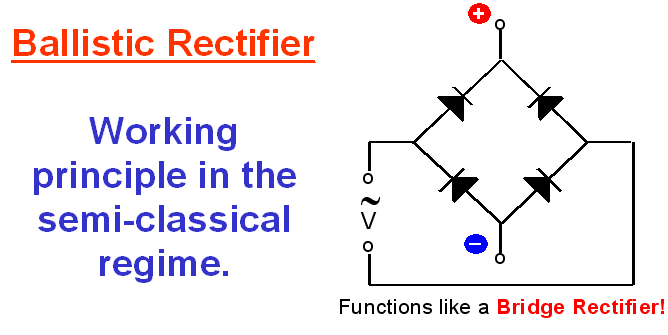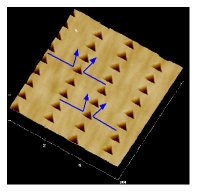Playing Electrons like Billiard Balls
Below is a "movie" showing how one of our nano-devices, Ballistic Rectifier, works, which is completely different from a conventional diode or rectifier.

The dark regions in the image represent insulating areas, and therefore the triangular area in the middle of the cross junction will deflect electrons (like billiard balls) downward. When an AC voltage is applied to the left and right leads, the accumulation of electrons in the lower lead gives rise to a DC output between the lower and upper contacts. As a result, the ballistic rectifier works like a bridge rectifier, but this is a completely new device concept.
The full working principle is
certainly more complicated than the picture above. Please note that the device
must be very small and made of very "clean" semiconductor. That is
why nano-technology and advanced semiconductor materials are essential, and why there is a lot of
fun, too.
are essential, and why there is a lot of
fun, too.
The ballistic rectifier was the first ever novel nano-electronic device that was reproducibly made by standard nanolithography (therefore can be mass produced) and also functioned at room temperature. We demonstrated that it worked up to at least 50 GHz, a lot faster than a conventional diode, because of the new working principle.
Based on a similar working principle, we have also designed an artificial material. One can cut a piece from it and use the piece as an individual device. Our artificial material is, to our knowledge, the first nanostructured artificial electronic material ever made. Like the ballistic rectifier shown above, it was also demonstrated to function at frequencies up to at least 50 GHz at room temperature. The device has potential to operate at much higher frequencies, well into the THz (1,000 GHz) range.
Currently, the device is being exploited for energy harvesting applications, due to its ultra-high speed and zero threshold. Another exciting thing is the discovery of pronounced "quantum effects" in nanometre-sized ballistic rectifiers and artificial materials, in which electrons actually behave like waves....
If you want to know more details, please contact Professor Aimin M. Song.
References:
Scientific articles:
- A. Löfgren, I. Shorubalko, P. Omling, A. M. Song, Phys. Rev. B67, 195309 (2003).
- A. M. Song, Special issue “Ratchets: Basics, Experiments and Applications”, (Invited Review Paper) Applied Physics A, Vol. 75, 229 (2002).
- A. M. Song, P. Omling, L, Samuelson, W. Seifert, I. Shorubalko, and H. Zirath, Express Letter in Jpn. J. Appl. Phys. Vol. 40, No. 9, L909 - L911 (2001).
- A. M. Song, P. Omling, L, Samuelson, W. Seifert, I. Shorubalko, and H. Zirath, Appl. Phys. Lett. Vol. 79, No. 9, 1357-1359 (2001).
- A. M. Song, Phys. Rev. B59, 9806-9809 (1999).
- A. M. Song, A. Lorke, A. Kriele, J. P. Kotthaus, W. Wegscheider, and M. Bichler, Phys. Rev. Lett. Vol. 80, 3831-3834 (1998).
Book Chapters:
- Room-temperature nanodevices, A. M. Song, (Invited Book Chapter), Encyclopedia of Nanoscience and Nanotechnology, American Scientific Publishers, (2003).
- Electron Ratchets--Nonlinear Electron Transport in Semiconductor Dot and Antidot Structures, H. Linke and A. M. Song, (Book Chapter), Electron Transport in Quantum Dots, edited by J. P. Bird (Kluwer Academic/ Plenum Publishers, October, 2003).
Other references:
- Ragnar Fleischmann and Theo Geisel, Phys. Rev. Lett. Vol. 89, 016804 (2002).
- Markus Büttiker and David Sánchez, Phys. Rev. Lett. Vol. 90, 119701 (2003).
- Theo Geisel and Ragnar Fleischmann, Phys. Rev. Lett. Vol. 90, 119702 (2003).
- B G Vasallo, T Gonz´alez, D Pardo and J Mateos, Nanotechnology, Vol. 15, S250 (2004).
- S. de Haan, A. Lorke, J. P. Kotthaus, W.Wegscheider, and M. Bichler, Phys. Rev. Lett. Vol. 92, 056806 (2004).